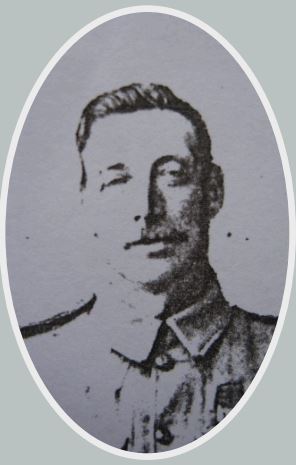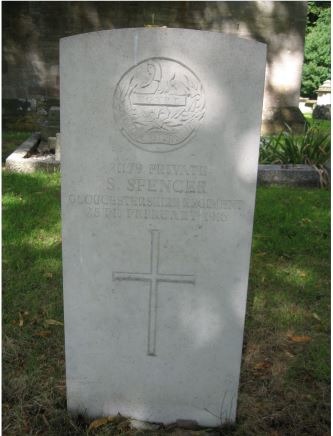3rd Battalion, Gloucestershire Regiment

Samuel John Spencer was born in Stonehouse, Gloucestershire in 1871, the son of John and Fanny Spencer: he was one of twelve children born to the couple by the time of the 1911 Census, eight surviving. He married Flora Griffin in 1904 and the 1911 Census records the couple living at 1 Hunt Court Cottage, Bentham, near Cheltenham. Samuel was recorded as a cowman. The couple had had three children by 1911, two surviving and at the time of his death there were four surviving children.
Unfortunately no Army service record has survived for Samuel but the Cheltenham Chronicle of 13 May 1916 did report his funeral (oddly, just over two months after the event but after the above photo was published in the Gloucestershire Graphic) and the report does give some insight into his military service.
Prior to the Great War, Samuel served for twelve years in the Rifle Brigade, principally in India and saw action during some frontier expeditions and he was awarded a medal for his service. He probably enlisted around 1890 and he his twelve years with the colours may have come to an end in the early 1900s, prior to his marriage in 1904. After leaving the Army he became an agricultural labourer, as evidenced by the occupation shown in the 1911 Census.
Upon the outbreak of war he re-enlisted and joined the Gloucestershire Regiment, being posted to the 1st Battalion (part of 3 Brigade, 1 Division). His Medal Index Card shows that he went to France on 29 June 1915 and the above newspaper report states that he took part in the Battle of Loos, which took place between 25 September and 8 October. The report states that he was ‘gassed and buried in a mine explosion but rescued with severe injuries’. The 1st Glosters attacked at the northern end of the battlefield on 25 September, near to the Hulluch – Vermelles road. This day saw the first use of gas by the British but the attack was hampered when it blew back into the British lines at the start of the attack. If Samuel was involved in the 25 September attack it is more likely that he was buried by a shell explosion, rather than a mine (there is no mention of any mine explosion in the battalion War Diary). The War Diary does record the fact that 30 men were affected by gas shelling, at the point where the 1st Glosters were being relieved by the Lincolns on 26 September. The battalion was also subjected to gas and high explosive shelling on 7/8 October. His injuries were severe enough for him to be repatriated to hospital in England and upon recovery he was posted to the 3rd (Reserve) Battalion at Gravesend in Kent. He was given one month’s furlough to work on a farm at Oxlynch, near Standish but was taken seriously ill with pneumonia and he died, on 28 February 1916, in Stroud General Hospital. He was aged 45 years.
Samuel Spencer was buried in Standish (St Nicholas) Churchyard on 4 March 1916, with semi-military honours and his grave is now marked by a standard CWGC headstone.

Researched by Graham Adams 27 February 2017
